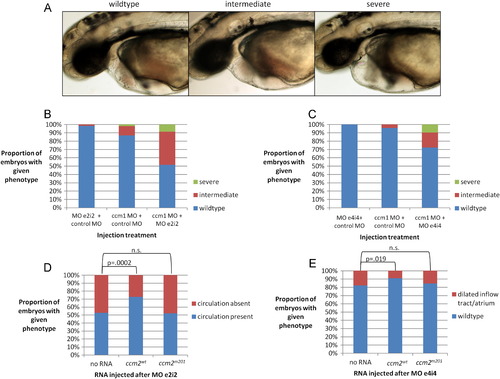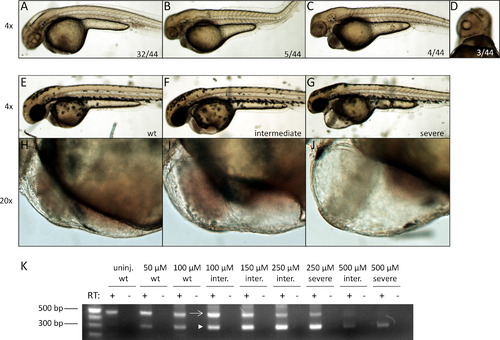- Title
-
Ccm2-like is required for cardiovascular development as a novel component of the Heg-CCM pathway
- Authors
- Rosen, J.N., Sogah, V.M., Ye, L.Y., and Mably, J.D.
- Source
- Full text @ Dev. Biol.
|
Sequence and expression analysis of ccm2l. (A) Alignment of Ccm2l and Ccm2 protein sequences. (B) Schematic comparing the domain structures of Ccm2l and Ccm2. The N-terminal region of Ccm2l contains a putative PTB domain with high identity to the PTB domain of Ccm2. The two proteins also have regions of high identity at their C-termini. (C) RT-PCR showing expression of ccm2, ccm2l, ccm1 and the positive control gapdh at five embryonic stages. All four genes are expressed at all five time points tested between 0 and 48 hpf. Water (w) is included as a negative control. (D) RT-PCR comparing expression of ccm2l and ccm1 in whole embryos (e) and purified embryonic hearts (h) at 48 hpf. Both genes are expressed in the heart, with the ratio of heart expression to whole embryo expression much higher for ccm2l. RT-PCR for the heart-specific marker cardiac myosin light chain (cmlc2) and for a transcript absent from the heart, insulin (ins), demonstrate the quality of the heart tissue purification. (E) In situ hybridization analysis of ccm2l expression. In 30 hpf embryos, ccm2l expression is detected in the posterior end of the embryo in the presumptive notochord (arrowheads) and the tissue ventral to it (arrows). Embryos treated with sense probe as a negative control lack staining in these domains. PH, Pleckstrin-homology superfamily; PTB, phosphotyrosine binding domain; w, water. |
|
ccm2l morphants exhibit heart and inflow tract defects. (A) Injection of MO e2i2 increases production of an endogenous alternatively spliced product (arrow) at the expense of the presumptive functional transcript (arrowhead). (B) Sequencing reveals that the alternatively spliced ccm2l mRNA, which is observed at increased levels in embryos injected with MO e2i2, incorporates intron 2, leading to an in-frame stop codon. (C and F) Uninjected embryos have compact heart chambers and narrow inflow tracts. (D,E,G,H) Embryos injected at the one-cell stage with 0.3 pMol MO e2i2 (D and G) or 1.0 pMol MO e4i4 (E and H) exhibit dilation of the atrium and inflow tract. Embryos injected with MO e2i2 often have a curved body axis. All images are taken from a lateral perspective with anterior to the left. a, atrium; i.t., inflow tract. PHENOTYPE:
|
|
Effects of ccm2l disruption on embryonic vasculature. (A and B) At 52 hpf, control embryos have an appropriately constricted endocardium, while ccm2l morphants exhibit endocardial dilation. (Arrows show lumen diameter). (C and D) Morphology of the CCV at 52 hpf is generally normal in ccm2l morphants. (E and F) At 58 hpf, ISVs are mostly insensitive to ccm2l loss-of-function, although some affected embryos have ISVs that are not fully dilated (arrowhead). (G and H) At 72 hpf, SIVs in affected embryos are frequently mispatterned. (I–K) At 52 hpf, MsVs are approximately the same width in control embryos and affected embryos (arrowheads). A and B are 20× magnification; C–J are 10× magnification. A–F are taken from a lateral perspective with anterior to the left; G and H are dorsal images with anterior to the right. I and J are taken from a dorsal perspective with the anterior end tilted upward. In K, error bars represent standard error. Cont, standard control morpholino. PHENOTYPE:
|
|
ccm2l interacts genetically with the Heg-CCM pathway. (A–C) For enhancer experiments, embryos were injected with low doses of control morpholino, ccm1 morpholino and ccm2l morpholino in pairwise combinations and assayed at 52 hpf for heart morphology and function. (A) Embryos classified as “wildtype” have a heart and inflow tract comparable to uninjected embryos and strong blood circulation. “Intermediate” embryos exhibit moderate dilation of the atrium and inflow tract but maintain some level of blood circulation. “Severe” embryos have extreme dilation of the heart and inflow tract and lack blood circulation. (B and C) Compared to a control morpholino with no predicted cellular targets, MO e2i2 and MO e4i4 both increase the proportion of moderate and severe phenotypes in embryos sensitized with ccm1 morpholino. Images of embryos were taken at 10x magnification from a lateral perspective with anterior to the left. Graphs represent data pooled from at least three independent experiments. For each group, n>98 embryos. (D,E) For rescue experiments, embryos were injected with ccm2l morpholino and subsequently injected with mRNA transcribed in vitro from either wildtype ccm2 cDNA (ccm2wt) or from cDNA corresponding to the ccm2 mutant allele ccm2m201. (D) ccm2wt RNA rescued circulation in a significant proportion of embryos injected with MO e2i2, while ccm2m201 RNA did not. (E) Similarly, ccm2wt RNA but not ccm2m201 RNA rescued heart and inflow tract morphology in a significant proportion of embryos injected with MO e4i4. Embryos exhibiting an enlarged inflow tract and/or enlarged atrium were labeled as “dilated inflow tract/atrium.” Graphs represent data pooled from three independent experiments. For each group, n>130 embryos. p-values are calculated from a 2×2 contingency table using Fisher′s exact test. n.s., not significant. PHENOTYPE:
|
|
ccm2l interacts genetically with the Heg-CCM pathway. (A–C) For enhancer experiments, embryos were injected with low doses of control morpholino, ccm1 morpholino and ccm2l morpholino in pairwise combinations and assayed at 52 hpf for heart morphology and function. (A) Embryos classified as “wildtype” have a heart and inflow tract comparable to uninjected embryos and strong blood circulation. “Intermediate” embryos exhibit moderate dilation of the atrium and inflow tract but maintain some level of blood circulation. “Severe” embryos have extreme dilation of the heart and inflow tract and lack blood circulation. (B and C) Compared to a control morpholino with no predicted cellular targets, MO e2i2 and MO e4i4 both increase the proportion of moderate and severe phenotypes in embryos sensitized with ccm1 morpholino. Images of embryos were taken at 10x magnification from a lateral perspective with anterior to the left. Graphs represent data pooled from at least three independent experiments. For each group, n>98 embryos. (D,E) For rescue experiments, embryos were injected with ccm2l morpholino and subsequently injected with mRNA transcribed in vitro from either wildtype ccm2 cDNA (ccm2wt) or from cDNA corresponding to the ccm2 mutant allele ccm2m201. (D) ccm2wt RNA rescued circulation in a significant proportion of embryos injected with MO e2i2, while ccm2m201 RNA did not. (E) Similarly, ccm2wt RNA but not ccm2m201 RNA rescued heart and inflow tract morphology in a significant proportion of embryos injected with MO e4i4. Embryos exhibiting an enlarged inflow tract and/or enlarged atrium were labeled as “dilated inflow tract/atrium.” Graphs represent data pooled from three independent experiments. For each group, n>130 embryos. p-values are calculated from a 2×2 contingency table using Fisher′s exact test. n.s., not significant. |

Unillustrated author statements PHENOTYPE:
|
Reprinted from Developmental Biology, 376(1), Rosen, J.N., Sogah, V.M., Ye, L.Y., and Mably, J.D., Ccm2-like is required for cardiovascular development as a novel component of the Heg-CCM pathway, 74-85, Copyright (2013) with permission from Elsevier. Full text @ Dev. Biol.





